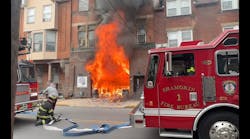It is a topic that pits the personal safety of employees against an employer’s right to control the workplace; the constitutional rights of one employee against the safety concerns of co-workers. Should fire and EMS personnel who are legally able to carry a firearm be allowed to carry while on duty?
The wisdom of arming firefighters and EMS personnel raises many issues. This article will address some of the more important legal issues that are associated with the decision to allow or disallow on-duty carry. A disclosure is warranted up front, because when dealing with controversial topics, one’s biases inevitably influence one’s perspective. I am pro-gun and a card-carrying Patriot Benefactor Life-Member of the National Rifle Association. This disclosed, let us delve into the issues.
Prohibition
Can an employer legally prohibit an employee who has a legal right to carry a firearm from carrying on duty? The simple answer is, yes, in most states. An employer can prohibit an employee from carrying a firearm on duty and regulate the type of weapons that an employee can possess at work, the type of ammunition that is carried and related issues. Kansas and Kentucky are two states that are notable exceptions, where public employers are prohibited from regulating anyone’s right to carry, including their own employees.
Take a look at Kentucky’s law:
65.870 Local firearms control ordinances prohibited—Exemption from immunity—Declaratory and injunctive relief.
(1) No existing or future city, county, urban-county government, charter county, consolidated local government, unified local government, special district, local or regional public or quasi-public agency, board, commission, department, public corporation, or any person acting under the authority of any of these organizations may occupy any part of the field of regulation of the manufacture, sale, purchase, taxation, transfer, ownership, possession, carrying, storage, or transportation of firearms, ammunition, components of firearms, components of ammunition, firearms accessories, or combination thereof.
(2) Any existing or future ordinance, executive order, administrative regulation, policy, procedure, rule, or any other form of executive or legislative action in violation of this section or the spirit thereof is hereby declared null, void, and unenforceable.
Under such a law, a municipal fire department is prohibited from having any policy, procedure, rule or regulation that governs the possession or carrying of firearms. Although it might be argued that the drafters of this law intended to prohibit local government officials from enacting ordinances and policies that apply to members of the public, as opposed to limiting fire chiefs from regulating their employees, the state’s attorney general issued an advisory opinion that concludes that the law governs employment policies as well.
Notwithstanding Kansas and Kentucky, in most states, an employer can regulate whether employees are allowed to carry weapons while at work. Although the Second Amendment stands for the right of a person to be able to own, possess and use firearms, it has not been interpreted so broadly as to limit the rights of employers to regulate such possession and use in the workplace.
The safe workplace
Should an employer prohibit an employee who has a legal right to carry a firearm from carrying on duty? The answer to this question raises a number of difficult legal issues. Let us start with an employer’s obligation to each employee to provide a safe workplace.
Under the Occupational Safety and Health Act, an employer has a duty to provide a workplace that is free from recognized hazards. This duty is referred to as the general duty requirement. Under the general duty requirement an employer is required to identify recognized hazards to which employees might be exposed and to take affirmative steps to manage the risks.
The general duty requirement poses an unresolvable paradox for fire chiefs in regard to firearms. If we acknowledge that our workplace poses a recognized hazard in terms of potential violence to employees, it can be argued that denying an employee who can legally carry a firearm the right to carry violates the general duty requirement.
On the other hand, if a fire department allows employees to carry, the employer would then be under an affirmative obligation to protect all employees from the foreseeable risks that are associated with co-workers who carry firearms in the workplace. In addition, an anti-gun employee can allege a general duty violation by virtue of the fact that the employer is allowing on-duty carry.
Part of addressing the recognized hazard aspect of firearms in the workplace would involve training all personnel in the safe handling of firearms. Given the prevalence of firearms in society, basic firearms safety knowledge ought to be something that all personnel have. Safe handling of firearms may be an issue if an armed firefighter becomes incapacitated, as well as if personnel come upon an armed but incapacitated patient. Although an acceptable classroom answer may be to have the police handle all firearm-related matters, real life may not allow for immediate police availability and response.
Among the issues that are raised by the general duty requirement:
- Establishing minimum competencies for members who want to carry. Besides the obvious shooting proficiencies, consideration should be given to advanced training on shoot/don’t shoot scenarios, given the risk to co-workers and others who might be downrange. Perhaps the most important competency to be considered is the most difficult to measure: mature judgment.
- Steps to ensure weapon retention. In other words, how do we ensure that the member’s weapon will not be taken by a third-party while the member is engaged in a common evolution, such as delivering patient care or carrying a stair chair/stretcher? Police officers are trained to instinctively protect their weapon, and perhaps firefighters who carry need training to develop the identical instincts. This raises questions not just about weapon-retention training but holstering systems and concealed versus open carry.
- Safe storage of firearms while members are engaged in activities, such as showering or sleeping.
- Legal storage of firearms when members respond to prohibited areas, such as post offices, prisons, courthouses and federal properties, where carry is prohibited.
- Standardization of weapons, ammunition, retention systems and carry methods.
- Ongoing training to maintain skills.
Another competency-related concern that is not so much a general-duty issue deals with ensuring that personnel have training in alternatives to deadly force, including de-escalation techniques and less-lethal alternatives.
Liability
Most gun owners are highly aware that a firearm is a deadly force weapon that only can be drawn and/or pointed in the direction of another person when confronted with deadly force. In most jurisdictions, firearms cannot be used to protect property. Furthermore, the discharge of a firearm even in a bona fide self-defense or defense-of-others situation carries life-altering civil and criminal consequences for the shooter.
However, the legal requirements for armed governmental agents go beyond what most gun owners contemplate. Let me make this point as clear as possible: A public sector firefighter is a government agent. When armed, on-duty firefighters face additional liability concerns, because they are acting as agents of government.
There is a line of cases that involve police officers that holds that the use of excessive force when detaining or arresting a citizen not only constitutes a false arrest but violates the Fourth Amendment to the U.S. Constitution. The displaying, drawing or pointing of a firearm by a governmental agent can constitute excessive force. As such, a firefighter who displays, draws or points a firearm at someone under circumstances where in hindsight it is not justified triggers a possible civil rights violation.
Peace officers who act in good faith with probable cause but make a mistake are entitled to a privilege against claims for false arrest. Non-peace officers do not enjoy this privilege. In other words, when an on-duty firefighter pulls a gun in good faith with probable cause, that firefighter does not enjoy the privilege that is enjoyed by a police officer.
Firefighters need additional training in this regard, because there is no room for even a good faith mistake. As an agent of government, a firefighter who points a firearm at a person to stop that person from doing what he/she is doing risks being liable for false arrest and a civil rights violation, without the benefit of a police officer’s liability defense in the event that a mistake is made.
In preparing to write this column, I contacted some of the nation’s top firearms defense attorneys as well as attorneys who regularly represent police officers in officer-involved shooting cases. None of the attorneys ever contemplated the legal challenges that are associated with non-peace officer firefighters being armed. Each agreed that firefighters who carry on duty need additional training that goes beyond that which is required in most states for concealed carry certification—and perhaps beyond that which is required for police officers, because of the lack of privilege.
What is beyond question is the need for training of firefighters who plan to carry on-duty. Carrying a firearm on-duty poses liability concerns that go beyond those that are posed by off-duty carry.
Do it right
Like many challenging questions these days, people’s minds about this subject probably were made up prior to reading what is written here. There is little that I can offer that is likely to change that. In the end, the decision to allow firefighters to carry firearms is not so much a legal question as it is a political and social question that rightfully might have different answers in New York City and Kalispell, MT.
For fire departments that allow their personnel to carry as well as those that are considering it, my advice is: If you are going to do it, do it right. That means address the issues that are outlined above, ensure members get the necessary training and provide ongoing support for the program. If you are not prepared to do that, do not allow your members to carry.






